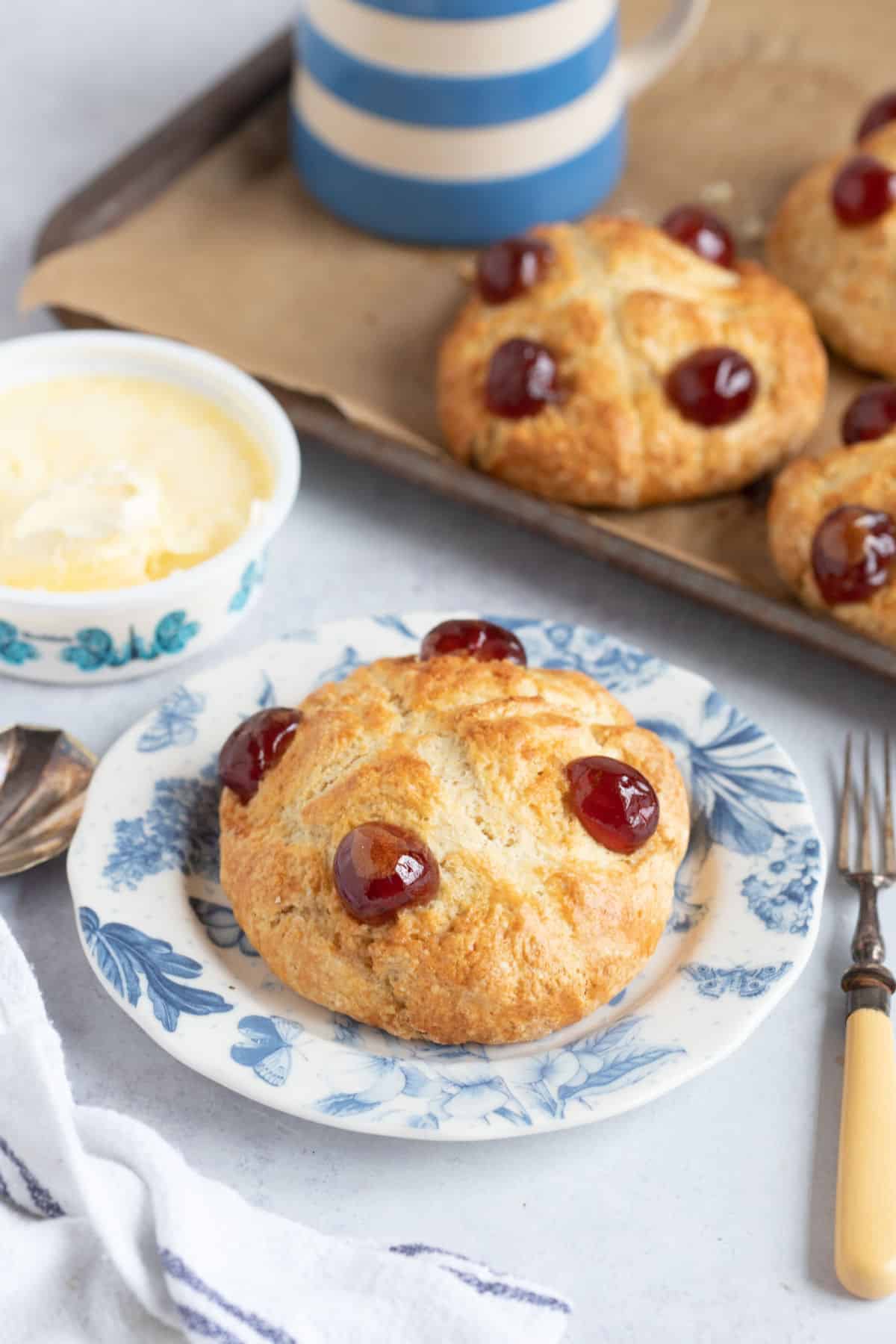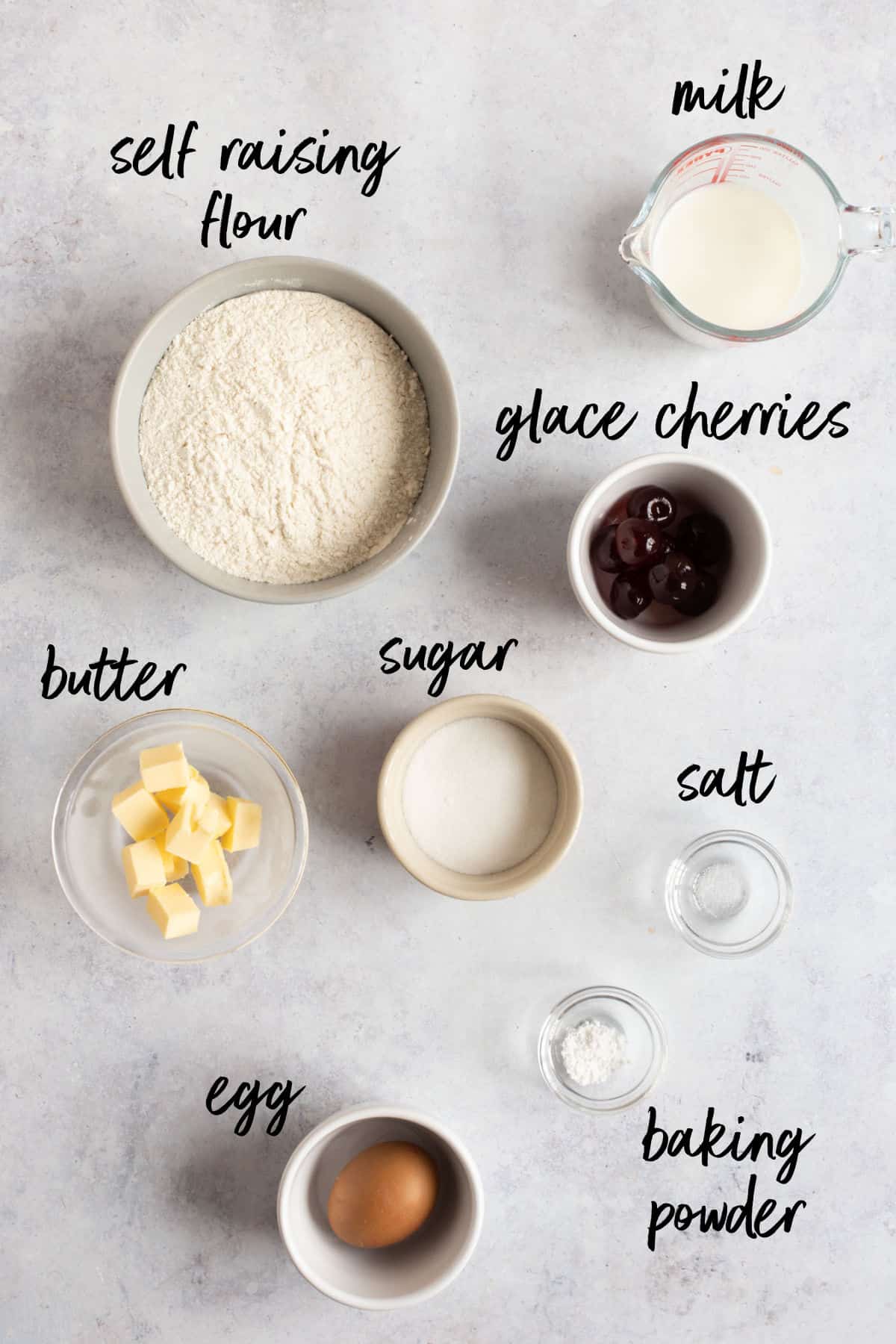Victoria scones are a classic British tea-time treat that are easy to make. With just a few simple ingredients, you can whip up a delicious batch perfect for sharing with friends and family.
With a crisp outside and a soft, fluffy inside, this easy scone recipe will quickly become your favourite afternoon tea snack!

Would you like to save this?
This site is protected by the Google Privacy Policy and Terms of Service apply.
Serve the scones warm out of the oven with strawberry jam and clotted cream, or enjoy them on their own with a cup of tea.
👩🍳Love baking scones? Try my easy air fryer scones or air fryer fruit scones next!
Jump to:
History of Victoria Scones
It's believed that the recipe for these scones was created in the early 19th century during the Victorian era.
Queen Victoria herself was known to enjoy a good scone, and it's said that she would often have them served to her with her afternoon tea.
Over time, the recipe for Victoria scones evolved and became more refined. In 1928, the Be-Ro Recipe Book was published, which included a recipe for these scones that is still widely used today.
The Be-Ro recipe calls for self-raising flour, which was a new invention at the time. This ingredient made it much easier to create light and fluffy scones, and it quickly became a staple in many British kitchens.
Today, Victoria scones are a beloved treat that can be found in bakeries and cafes throughout the UK. They are often served with jam and clotted cream, and are a popular choice for afternoon tea.
✔️ Why you'll love this recipe!
- Made with just a few basic ingredients and requiring minimal preparation time, these scones are incredibly easy to whip up.
- Ideal for sharing, scones are a fantastic choice for gatherings, picnics, or special occasions.
- Victoria scones are freezer-friendly, so consider baking a double batch to enjoy later!
🛒 Ingredient notes

225g self-raising flour, plus extra for dusting: This flour contains a raising agent, making it ideal for scones. The extra flour prevents sticking while rolling out the dough.
¼ teaspoon baking powder: A leavening agent that helps the scones rise, ensuring a light and fluffy texture when combined with self-raising flour.
50g cold unsalted butter, cut into cubes: Essential for a tender, flaky scone. Keeping the butter cold ensures even distribution in the dough.
50g caster sugar: A fine sugar that dissolves quickly, adding a subtle sweetness without overpowering the other flavours.
100ml whole milk, plus extra for glazing: Provides moisture and richness. The extra milk is used for glazing, giving the scones a golden-brown finish.
1 large egg, beaten: Adds structure, moisture, and richness, contributing to a tender crumb and golden colour.
Pinch of salt: Enhances flavour and balances sweetness, crucial for a well-rounded taste.
8 glace cherries: Candied cherries that add sweetness and colour to the scones.
🔪 How to make Victoria Scones
The recipe card with ingredient quantities and detailed instructions can be found at the bottom of the post
One: Preheat your oven to 200°C (180°C fan/ 400F/ gas mark 6) and line a baking tray with non stick parchment paper.
Two: In a large mixing bowl, combine the self-raising flour, baking powder, and a pinch of salt.
Three: Add the cold, cubed butter to the dry ingredients, and rub the butter into the flour with your fingertips until it resembles coarse breadcrumbs. Stir in the caster sugar.
Four: Whisk together the beaten egg and milk. Create a well in the centre of the dry ingredients, and pour in the wet mixture. Use a dinner knife to gently mix the wet and dry ingredients together until just combined. Be careful not to overmix, as this can result in tough scones.

Five: Turn the dough out onto a lightly floured surface and gently pat it out to about 2.5cm thickness. Divide the dough into four equal pieces and use your hands to shape each piece into a round.
Six: Place the scones onto the prepared baking tray, leaving enough space between them for expansion. Score a cross on the top of each scone (being careful not to drag the knife through the dough, but instead gently press into the dough). Brush the tops of the scones with a little milk and top each one with 4 glace cherry halves. Bake for 12-15 minutes until golden brown.

Top Tips
- Using cold butter helps create a flaky, tender texture in your scones. Make sure to cut it into small cubes and work quickly to avoid warming it up with your hands.
- When combining the wet and dry ingredients, mix gently until just combined. Overmixing can cause the scones to become tough.
- Give your scones enough room on the baking tray to allow for expansion while baking.
- Make sure your oven is fully preheated before baking your scones, as this helps them to rise quickly and evenly.
- All ovens vary, so keep a close eye on your scones and adjust the baking time as needed. Look for a golden-brown colour and a slight firmness to the touch as indicators that they are ready.
🍴 Serving suggestions
Traditionally, scones are served with clotted cream and strawberry jam. Here are some additional toppings you might consider:
- Whipped cream
- Lemon curd
- Raspberry or blackberry jam
- Honey
- Butter
Serve your scones with a cup of tea, coffee, or a glass of cold milk.

📖 Variations
- Add vanilla extract to the scone dough for extra flavour.
- Mix in dried fruit, such as raisins, currants, or sultanas, for a sweet, fruity flavour.
- Substitute some or all of the self-raising flour with wholemeal flour for a heartier, more rustic scone.
- Add 100g of chocolate chips to the scone mix for chocolate scones.
- Add the zest of one lemon to the dry ingredients before rubbing in the butter for extra zing.
🥡 Storage
Store - Freshly baked scones are best enjoyed on the day they are made. However, if you need to store them for a short period, you can keep them at room temperature in an airtight container for up to 2 days.
Reheat - You can reheat them in the oven at 150°C for about 5-8 minutes.
Freeze - Scones can be frozen for up to 3 months. To freeze, ensure they have completely cooled, then place the scones in an airtight container or freezer bag.

❓ Frequently asked questions
Yes, you can substitute plain flour for self-raising flour. For every 100g of plain flour, add 1.5 teaspoons of baking powder to achieve a similar result.
There could be several reasons for this, such as overworking the dough, using old or ineffective raising agents, or not preheating the oven to the correct temperature.
Yes, feel free to customise your scones by adding your favourite ingredients, like dried fruits, nuts, or chocolate chips. Just be careful not to overmix the dough when incorporating the additions.
Victoria scones typically include the addition of an egg in the recipe, which contributes to a richer, more tender, and slightly moist crumb compared to regular scones.
Victoria scones are best served warm, with strawberry jam and a dollop of clotted cream. They're often served as part of a traditional British afternoon tea, along with cucumber sandwiches and other pastries.
😋 More easy scone recipes
- Date & Walnut Scones
- Currant Scones
- Cherry & Almond Scones
- Air Fryer Cheese Scones
- Air Fryer Rock Buns

Don't forget to subscribe to the newsletter to stay up to date with what's cooking in the Effortless Foodie kitchen! You can also follow me on Facebook, Twitter, and Instagram too!
Recipe
Easy Victoria Scones Recipe
Would you like to save this?
This site is protected by the Google Privacy Policy and Terms of Service apply.
Ingredients
- 225 g Self Raising Flour
- ¼ teaspoon Baking Powder
- ⅛ teaspoon Salt
- 50 g Butter cold and cubed
- 50 g Caster Sugar
- 1 Egg large
- 100 ml Whole Milk plus extra for glazing
- 8 Glace Cherries halved
Instructions
- Preheat your oven to 200°C (180°C fan/ 400F/ gas mark 6) and line a baking tray with non stick parchment paper.
- In a large mixing bowl, combine the self-raising flour, baking powder, and a pinch of salt.225 g Self Raising Flour, ¼ teaspoon Baking Powder, ⅛ teaspoon Salt
- Add the cold, cubed butter to the dry ingredients, and rub the butter into the flour with your fingertips until it resembles coarse breadcrumbs.50 g Butter
- Stir in the caster sugar.50 g Caster Sugar
- Whisk together the beaten egg and milk. Create a well in the centre of the dry ingredients, and pour in the wet mixture. Use a dinner knife to gently mix the wet and dry ingredients together until just combined. Be careful not to overmix, as this can result in tough scones.1 Egg, 100 ml Whole Milk
- Turn the dough out onto a lightly floured surface and gently pat it out to about 2.5cm thickness. Divide the dough into four equal pieces and use your hands to shape each piece into a round.
- Place the scones onto the prepared baking tray, leaving enough space between them for expansion. Score a cross on the top of each scone (being careful not to drag the knife through the dough, but instead gently press into the dough).
- Brush the tops of the scones with a little milk and top each one with 4 glace cherry halves. Bake for 12-15 minutes until golden brown.8 Glace Cherries
Notes
- Using cold butter helps create a flaky, tender texture in your scones. Make sure to cut it into small cubes and work quickly to avoid warming it up with your hands.
- When combining the wet and dry ingredients, mix gently until just combined. Overmixing can cause the scones to become tough.
- Give your scones enough room on the baking tray to allow for expansion while baking.
- Add vanilla extract to the scone dough for extra flavour.
- Mix in dried fruit, such as raisins, currants, or sultanas, for a sweet, fruity flavour.
- Substitute some or all of the self-raising flour with wholemeal flour for a heartier, more rustic scone.
- Add 100g of chocolate chips to the scone mix for chocolate scones.
- Add the zest of one lemon to the dry ingredients before rubbing in the butter for extra zing.








Laura
My Grandmother had that Bero cookbook and we always used to make these Victoria Scones together when I was a child.
Liz
I made these for a tea party brunch and they were a hit! Perfect taste and texture.
Dina Miller
Scones are what we are missing with our kitchen remodel. This recipe will be a keeper to try when kitchen is complete!
Carrie Robinson
These look absolutely perfect! And I love that the recipe for these uses self-rising flour. 🙂
Jacqueline
I've never heard of Victoria scones but they sure do look good and I did know she was a fan of Scottish scones so it makes sense she had her chefs make her own twist.
Tara
Such a wonderful addition to tea time! I especially love that texture and the glace cherry topping.